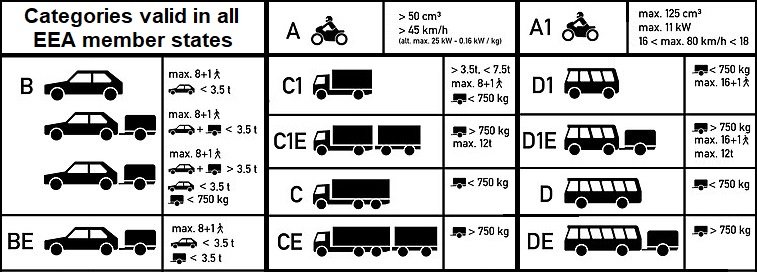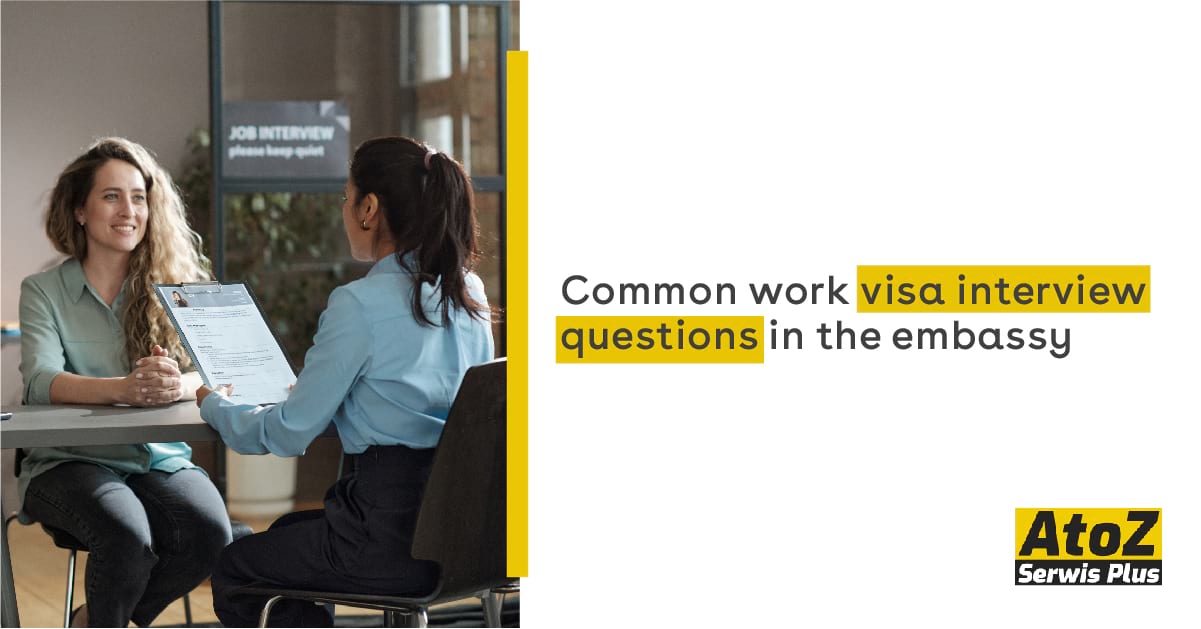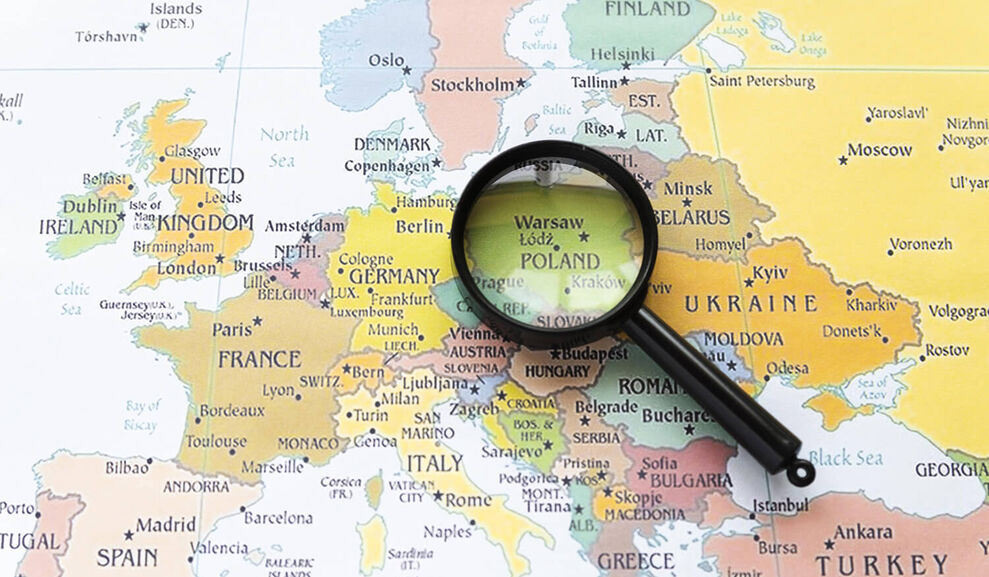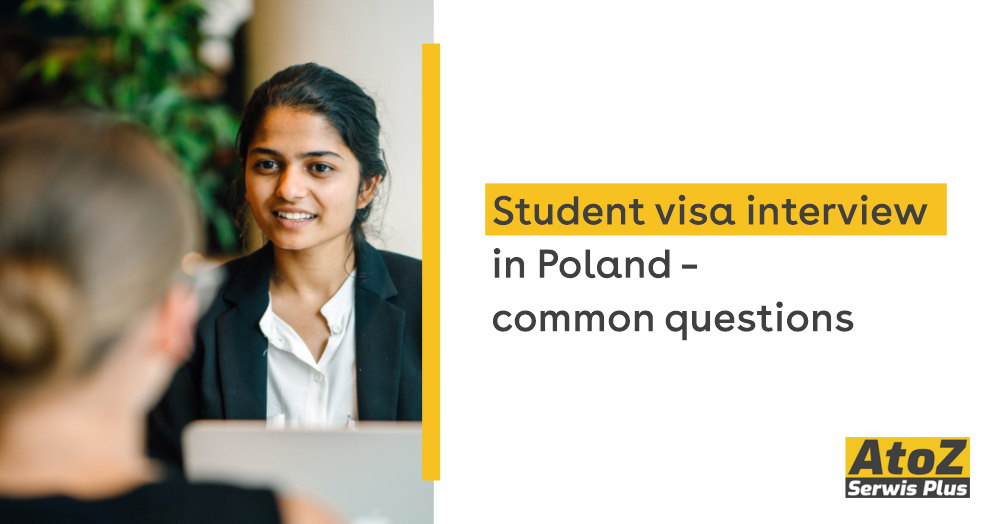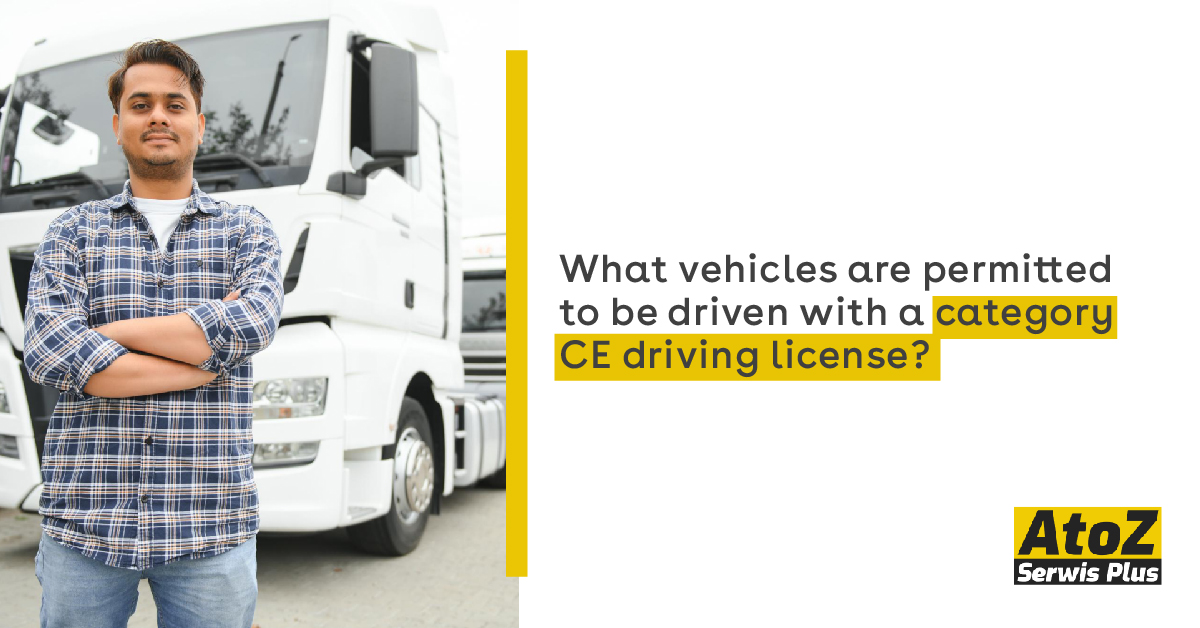

What vehicles are permitted to be driven with a Category CE driving license?
Driving a truck and towing a trailer with a maximum authorised mass of more than 750 kg are permitted under Category CE.
You must be at least 21 and possess a Category C driver's license to obtain a Category C license.
If you have finished the required training for a Driver Certificate of Professional Competence (CPC) or are currently undergoing it, you may be younger than 21.
Information about a vehicle or trailer, such as its maximum authorised mass, can be found in the Vehicle Registration Certificate.
European driving licence
The different previous driving license styles share features with the European driving license. It is issued by the 27 members of the European Union (EU) and the three European Free Trade Area (EFTA) members—Iceland, Liechtenstein, and Norway. Similar to a credit card, it has a microchip and a picture. These replaced the 110 different paper and plastic driver's licenses that the 300 million drivers in the EEA held. The main objective of the permit is to reduce the likelihood of fraud.
As long as the driver is of legal driving age, the license is not restricted or suspended, and it hasn't been revoked in the country of issuance, a driver's license issued by a member state of the European Union is accepted throughout the region. If a license holder moves within an EEA country, they can exchange their current license for a new one from that country. However, since all EEA licenses are recognised throughout the EEA, exchanging a driver's license is usually unnecessary.
Exemptions apply to people whose EEA driver's licenses were acquired in exchange for non-EEA licenses. It is important to remember that when moving to another country in the European Economic Area (EEA), a converted driver's license might need to be reissued as an official license from the new nation.
Past Events
1980–1996
On December 4, 1980, the Council of Ministers adopted Council Directive 80/1263/EEC on the introduction of a Community driving license. This was the first step toward creating a European driving license and guaranteed the mutual recognition of federal licenses by Member States. Additionally, it made it customary for license holders to relocate within a Member State and exchange licenses.
From 1996 to 2013
The Driving License Council of the European Union Directive 91/439/EEC was adopted by the Council of Ministers on July 29, 1991. The directive went into effect on July 1, 1996, and required EU Member States to pass legislation implementing it by that date. On the same day, Directive 80/1263/EEC was revoked.
By Decision of the EEA Joint Committee No. 7/94 of March 21, 1994, Directive 91/439/EEC—which outlined driving license requirements in the European Union and the European Economic Area—was incorporated into the EEA Agreement. It was repealed on January 19, 2013.
Provisions
Driving license categories were harmonised across the Member States by the Council of the European Union Directive 91/439/EEC, which also established two Community driving license models: a paper version and a plastic card version. It also showed a theoretical knowledge test and a practical skills and behaviour test that must be passed for someone to be eligible for a driving license. A candidate had to fulfil the minimal physical and mental health requirements to be eligible to apply. The directive established progressive access in categories A, C, and D, moving from light vehicles to larger or more powerful cars, and it set minimum ages for operating various vehicle types. According to the directive, the Member State where the license is issued must be the applicant's residence.
Modifications
Nine directives and two acts of accession significantly changed the Directive. Council Directive 96/47/EC of July 23, 1996, for example, added the plastic card version of the Community licence model to the Directive.
Relevance of EEA
The green and blue EEA
Directive 2006/126/EC states that it has European Economic Area (EEA) relevance, which means that by its incorporation into the EEA agreement, its provisions apply to all 27 EU member states as well as Iceland, Liechtenstein, and Norway.
By Decision of the EEA Joint Committee No. 29/2008 of March 14, 2008, amending Annex XIII (Transport) to the EEA Agreement, the Directive was included in the agreement.[10]The directive was modified by the decision in a few key ways. First, the words "driving licence" were added in Icelandic and Norwegian, and the phrase "European Communities model" was substituted with "EEA model." Secondly, the distinctive sign that issues the license is now surrounded by an ellipse rather than printed on the European flag.
Despite being an EFTA member, Switzerland is not a party to the EEA Agreement. Instead, through several bilateral agreements, Switzerland is connected to the EU and has primarily embraced the unified EU driving license laws. Since the 2000s, Switzerland has utilised car classification systems like those of the European Union. Swiss driver's licenses are similar to credit card licenses issued by the European Union but not the European Union.
Brexit
EU law continued to apply to the UK during the transition period following the UK's withdrawal from the EU, which ended on December 31, 2020, and Directive 2006/126/EC applied to the country during that time.
Beginning on January 1, 2021, drivers with European licenses who pass their driving test in an EU or EEA nation can use them in the UK, whether they are residents or just passing through. A UK driver's license can also be obtained by exchanging them.
With a few exceptions, UK driver's licenses are accepted when travelling to EU/EEA nations.
In certain situations, international driving permits may be required. A 1949 IDP (Geneva Convention on Road Traffic) or a 1968 IDP (Vienna Convention on Road Traffic) may be necessary in some EEA countries, depending on which convention the nation has ratified. But now, visitors staying for less than a year are allowed to obtain an IDP in any EEA nation.
Changes that are suggested
The European Commission published a proposal on March 1, 2023, to update the laws governing driver education, licensing, exams, and enforcing traffic infractions across international borders.
Concerning driver's licenses, the following measures were proposed:
The minimum age to obtain a driving license for cars and trucks has been lowered to 17. * The creation of a European digital driving license that is valid throughout the EU. * All license renewal, replacement, and exchange procedures have been digitalised.
Before becoming law, these proposals would need to pass the standard legislative process in the EU.
Digital licenses for mobile devices
Norway became the first nation in the EU/EEA to issue a mobile driving license nationwide through a proprietary app in July 2019. A limited trial conducted in Finland between 2018 and 2020 came before this. Since then, Iceland, Denmark, Germany, Spain, Greece, Poland, and Portugal have allowed mobile driving licenses. These portable and digital driver's licenses are only valid within the nation in which they are issued and feature proprietary implementations. This is expected to change on March 1, 2023, with the introduction of a standardised digital driving license for Europe by the new "Proposal for a Revision of the Directive on Driving Licences," which will follow the ISO 18013-5 standard.
Typical labelling for data fields
The purpose of numbering the data fields on the licence is to make it easier for users who speak different languages to comprehend what each one contains. Each field on the card is identified in the language of the issuing authority by a legend on the reverse side.
1. last name
2. alternative titles
3. place and date of birth
4. for administrative purposes, a different number from the one under heading 5; b) the date of issue; c) the date of expiry; d) the issuing authority; and
5. The license number
6. The holder's photo
7. The bearer's signature
8. address
9. Categories of licenses
10. The category's initial release date
11. The category's expiration date
12. Number-coded restrictions
13. a space set aside for the host Member State to potentially enter the information necessary for managing the license
14. A space is set aside for the potential entry of information about road safety or other pertinent topics by the Member State issuing the license (optional).
Categories that are appropriate for all EEA members
About AtoZ Serwis Plus
AtoZ Serwis Plus is a reputable and well-known B2C immigration agency that has been providing specialised immigration services since 2009. With company registration offices in Poland, Portugal, Malta, Germany, and Romania and partner offices in various countries worldwide, they offer individualised immigration services to clients globally.
Supported by Polish attorneys and with company registration numbers Regon: 382604058, NIP: 5252780856, KRS: 0000770916, AtoZ Serwis Plus Sp. z o.o. is a Polish Overseas Career Consultant and is considered one of the largest B2C immigration firms in Europe. They work closely with regulated and licensed immigration lawyers in their offices in Poland and Portugal.
AtoZ Serwis Plus has extensive experience managing international recruitment projects and specialises in providing staffing services. They assist individuals from countries such as Ukraine, Belarus, Moldova, Russia, Georgia, Armenia, Bangladesh, Nepal, India, and others in finding employment opportunities in Serbia, Croatia, Romania, Poland, Malta, Portugal, Germany, and other European countries.
Their services cater to individuals seeking professional growth and those looking to relocate permanently to Europe. AtoZ Serwis Plus charges reasonable fees for its services and offers flexible payment options.
Overall, AtoZ Serwis Plus aims to provide high-value immigration services, leveraging their expertise, international network, and partnerships to assist clients in achieving their career goals abroad.
For the Employer
Would you happen to need new employees? Our Immigration agency can assist you in finding the best candidates from various countries, including:
- CIS: Armenia, Azerbaijan, Belarus, Georgia, Kazakhstan, Kyrgyzstan, Tajikistan, Turkmenistan, Uzbekistan.
- Southeast Asia: Afghanistan, Bangladesh, India, Indonesia, Laos, Malaysia, Mongolia, Nepal, Pakistan, Philippines, Sri Lanka, Vietnam.
- Middle East: UAE, Turkey, Jordan, Yemen, Iraq.
- Africa: Nigeria, Algeria, Congo, Côte d'Ivoire, Egypt, Ghana, Morocco, Sierra Leone, Togo, Tunisia.
We take a personalised approach to each of our clients and ensure that we understand your specific needs and requirements for candidates before deciding on the cost of our services. It's a critical step in the recruitment process, and we ask that you fill in all the fields as thoroughly as possible to help us and the job applicants.
Step 1:
Could you fill out the employer's questionnaire? Please provide us with the necessary details about your job requirements and company. We'll use this information to customise our services for you. Fill in the form.
Step 2:
Please feel free to choose the best offer. Once we receive your completed questionnaire, we'll prepare a tailored proposal for recruitment, employee leasing, or outsourcing services.
Step 3:
Welcome your new employee. We'll utilise our extensive network and resources to find the ideal candidate for your business. Please don't worry; we'll ensure favourable conditions for you and the employee.
Take advantage of exceptional talent for your company. Complete the employer's questionnaire today, and let us handle your hiring needs.
How can AtoZ Serwis Plus assist you?
AtoZ Serwis Plus will provide the services listed below to get a European Country work visa:
- Counselling: Get AtoZ Serwis Plus’ free counselling services.
- Job services: Avail of AtoZ Serwis Plus’ job search services to find jobs in European Country
- Reviewing requirements: AtoZ Serwis Plus reviews all your European Country work visa requirements.
- Application process: We also help in completing your application process
- Requirements checklist: AtoZ Serwis Plus also helps you in arranging the requirements for a European Country work visa
- Complete visa application support
- Assistance with collecting supporting documentation
- Visa Interview Preparation – if required
- Updates and follow-up with the Consulate
Willing to work in a European Country? Talk to AtoZ Serwis Plus, Europe’s no. 1 overseas immigration consultant.
Would you like some advice? So that you know, the information I've included here is for you to review. You'll always need to consult with your legal and tax advisor(s) and follow their guidance. AtoZ Serwis Plus cannot assist with legal or tax matters. The information presented is not specific to any particular company or workforce nor reflects how AtoZ Serwis Plus products are distributed in any jurisdiction. Instead, it is general. AtoZ Serwis Plus makes no representations or warranties regarding this information's accuracy, completeness, or timeliness. It shall not be liable for any losses from using or relying on it. It is your responsibility to be careful when using this information.
Disclaimer: atozserwisplus.Pl is a FREE visa database and marketplace for immigration experts. This page's content does not provide legal advice. Before applying, kindly consult an expert.
